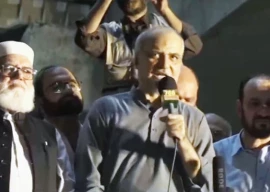
For City Editor Ataul Musawwir, who was away from the desk at that time, coverage of the Model Town violence on June 17 and the political upheaval in its aftermath has shone with the commitment of the reporters. Reporters Asad Kharal, Rameez Khan, Akbar Bajwa, Rana Yasif, Ali Usman and Rana Tanveer braved the scorching summer heat and went into the thick of things to make sense of the incident. Mohsin Yasin, a sub-editor on the desk, recalls that each new report on the Inqilab March of the Pakistan Awami Tehreek and the Azadi March of the Pakistan Tehreek-i-Insaf highlighted a new angle on the political situation in the country.
Aroosa Shaukat’s stories on the PTI’s colourful demonstrations do not tell the reader about her exciting experiences during the coverage. She had had to duck under containers and sprint, elbowing and shoving, through massive crowds to get the best possible story. She says it was worthwhile because it let her watch some of the most important political events in the county unfold before her eyes. “Talking to people, hearing perspectives and absorbing the energy around me were the best parts.”
The reporting by Abdul Manan and Rana Tanveer during the simultaneous attacks on two Ahmadi places of worship in 2010 has been the most comprehensive coverage of a terrorist attack in the city. Tanveer recalls that he was standing across the road from the Ahmadi ibbatdatgah in Garhi Shahu when terrorists barged into the building and started fi ring indiscriminately. He said the firing went on for several hours and then there was a deafening blast. Tanveer remembers the callousness of some reporters later at the press conference of Ahmadi leaders. “They kept raising litigious questions regarding their faith instead of focusing on the tragedy,” he says.
Another outstanding piece the Lahore desk considers a feather in its cap is Abdul Manan’s report on the denial of early relief to the community in flood-hit areas of South Punjab. The story went viral and Manan received several accolades for it.
An incident that snowballed into one of the worst failures of the public health sector was the death of hundreds of Punjab Institute of Cardiology (PIC) patients from consuming spurious drugs dispensed at the hospital. Ali Usman and Asad Kharal’s stories on the issue rankled nerves of several high-ranking officials and raised more questions than the authorities were keen to answer.
A piece that moved readers and the desk alike was Sonia Malik’s feature on aftermath of the suicide of a man after poisoning his wife and four children over debt bondage and poverty. Three of the children had died. Malik traced the wife and the fourth child, both of whom survived, and narrated their account of the incident. Malik recalls that she took up the topic for a feature report after a discussion with desk colleagues over lack of follow ups on such incidents which were frequently carried in papers as brief reports. She says the story remains one of her most meaningful ones because it enabled several social welfare organisations to reach out to the woman and the child for help. “It was also my first story for which the editor was happy about.”


















COMMENTS
Comments are moderated and generally will be posted if they are on-topic and not abusive.
For more information, please see our Comments FAQ